List of Sphenisciformes by population
| The population of birds |
|---|
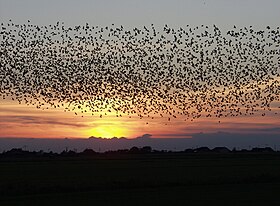 |
This is a list of Sphenisciformes species by global population. While numbers are estimates, they have been made by the experts in their fields.
A variety of methods are used for counting penguins, and April 2012 saw their first
Galápagos National Park Service. By land and sea, they carry out a full census in ten areas and partial census in four. The 2012 observation of 721 birds showed that levels have remained the same over recent years, and the current full estimate need not be changed.[6] For more information on how these estimates were ascertained, see Wikipedia's articles on population biology and population ecology
.
Species that can no longer be included in a list of this nature include the
global warming's effect on the latter may affect their numbers, and the chinstraps and gentoo, which both feed in open waters, have been making inroads into the Adélie and emperors' formerly ice-packed range. The gentoo have thus seen 7500% population growth since 1974, and the chinstraps 2700%.[9]
Species by global population
| Common name | Binomial name | Population | Status | Trend | Notes | Image |
|---|---|---|---|---|---|---|
| Galapagos penguin | Spheniscus mendiculus | 1800[10] | EN[10] | 
| ||
| Humboldt penguin | Spheniscus humboldti | 3300 – 12 000[11] | VU[11] | 
| ||
| Fiordland penguin | Eudyptes pachyrhynchus | 5000 – 6000[12] | VU[12] | Only mature individuals were included in the count.[12] | 
| |
| Yellow-eyed penguin | Megadyptes antipodes | 5930 – 6970[13] | EN[13] | Estimate is dated (1988/89).[13] | 
| |
| African penguin | Spheniscus demersus | 75 000 – 80 000[14] | EN[14] | 5000 breeding pairs in Namibia & 21 000 in South Africa.[14] | 
| |
| Snares penguin | Eudyptes robustus | 93 000[15] | VU[15] | 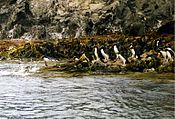
| ||
| Erect-crested penguin | Eudyptes sclateri | 195 000 – 210 000[16] | EN[16] | Population breeds in two locations: the Bounty Islands (26 000 pairs), & the Antipodes Islands (41 000 pairs).[16] | 
| |
| Northern rockhopper penguin | Eudyptes moseleyi | 530 000[17] | EN[17] | Only mature individuals were included in the count (265 thousand pairs); population has declined 57% in the past 37 years.[17] | 
| |
| Emperor penguin | Aptenodytes forsteri | 595 000[18] | NT[18] |

| ||
| Gentoo penguin | Pygoscelis papua | 774 000[19] | LC[19] |
Only mature individuals were included in the count (387 thousand pairs).[19] | 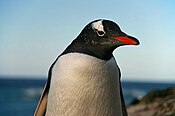
| |
| Royal penguin | Eudyptes schlegeli | 1 700 000[20] | NT[20] |
Only mature individuals were included in the count (850 000 pairs on Macquarie & over 1000 pairs on Bishop and Clerk). Estimate is from the 1980s, but population is stable.[20] | 
| |
| Southern rockhopper penguin | Eudyptes chrysocome | 2 460 000[21] | VU[21] | Only mature individuals were included in the count (1.23 million pairs); population has declined 34% in the past 37 years.[21] | 
| |
| Magellanic penguin | Spheniscus magellanicus | 2 600 000[22] | NT[22] |
Only mature individuals were included in the count (1.3 million pairs).[22] | 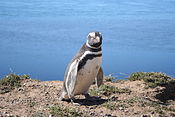
| |
| Adélie penguin | Pygoscelis adeliae | 4 740 000[23] | LC[23] |
Only mature individuals were included in the count (2.37 million pairs).[23] | 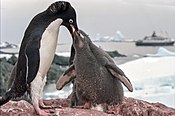
| |
| Chinstrap penguin | Pygoscelis antarcticus | 8 000 000[24] | LC[24] |
Minimum estimate.[24] | 
| |
| Macaroni penguin | Eudyptes chrysolophus | 18 000 000[25] | VU[25] | Only mature individuals were included in the count (9 million pairs); main population centres at Île des Pingouins, Heard and McDonald (1 million pairs each), Kerguelen (1.8 million pairs), & South Georgia (2.5 million pairs).[25] | 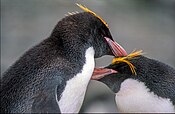
|
See also
- Lists of birds by population
- Lists of organisms by population
References
- . Retrieved 12 November 2021.
- . Retrieved 12 November 2021.
- ^ Dell'Amore, Christine (13 April 2012). "Emperor Penguins Counted From Space—A First". National Geographic News. National Geographic. Archived from the original on April 15, 2012. Retrieved 2012-12-22.
- ^ Yusuf, Mohammed (29 June 2012). "UNHCR Tries to Count Somalia". Voice of America. Retrieved 2012-11-21.
- .
- ^ "Annual Galapagos Penguin and Cormorant Census". GNP News. Proceso de Relaciones Públicas – Parque Nacional Galápagos – Ecuador. 2012. Retrieved 2012-12-22.
- ^ Fox, Rebecca (2008-11-20). "Ancient species of penguin found in DNA of bones". Otago Daily Times. Archived from the original on 2011-06-09. Retrieved 2008-11-20.
- ^ A.J.D. Tennyson and P.R. Millener (1994). Bird extinctions and fossil bones from Mangere Island, Chatham Islands[permanent dead link], Notornis (Supplement) 41, 165–178.
- ^ Than, Ker (1 Dec 2008). "3/4 of Big Antarctic Penguin Colonies to Disappear?". National Geographic News. National Geographic. Archived from the original on January 30, 2013. Retrieved 2012-12-22.
- ^ . Retrieved 12 November 2021.
- ^ . Retrieved 12 November 2021.
- ^ . Retrieved 12 November 2021.
- ^ . Retrieved 12 November 2021.
- ^ . Retrieved 12 November 2021.
- ^ . Retrieved 12 November 2021.
- ^ . Retrieved 12 November 2021.
- ^ . Retrieved 12 November 2021.
- ^ . Retrieved 12 November 2021.
- ^ . Retrieved 12 November 2021.
- ^ . Retrieved 12 November 2021.
- ^ . Retrieved 12 November 2021.
- ^ . Retrieved 12 November 2021.
- ^ . Retrieved 12 November 2021.
- ^ . Retrieved 12 November 2021.
- ^ . Retrieved 12 November 2021.
